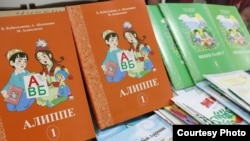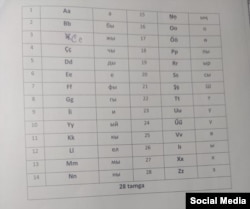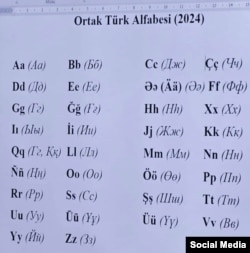BISHKEK -- The five countries of the Organization of Turkic States (OTS) have overcome years of disagreements about letters and diacritical marks to agree on a common Latin alphabet for their languages that consists of 34 letters.
Adopting a standard alphabet could prove relatively easy for Azerbaijan, Turkey, and Uzbekistan, who already use the Latin script, as well as Kazakhstan, which is in the process of transitioning away from Cyrillic.
But it remains a sensitive topic in Kyrgyzstan, the only OTS member that has not decided to switch to the Latin alphabet amid long-standing debates by scholars, politicians, and the public.
Syrtbai Musaev, a prominent linguist who represented Kyrgyzstan at an OTS meeting on the common alphabet in Baku on September 9-11, said a draft Latin-based Kyrgyz alphabet "is ready" and awaiting a "political decision" by the president and parliament.
But Kyrgyz President Sadyr Japarov has said it is premature for the country to abandon Cyrillic, which was imposed upon the former Soviet republics by Moscow.
"It is too early to talk about the transition of the Kyrgyz language to the Latin alphabet," Japarov has said. "This issue is not on the table now; the development of the state language should continue in Cyrillic."
Japarov made the remarks during a meeting last year with the chairman of the national commission on state language and language policy, Kanybek Osmonaliev.
Osmonaliev had told the parliament that if "the lawmakers and the president make the political decision [to replace Cyrillic], the Kyrgyz public and scholars were ready to transition to the Latin alphabet."
The alphabet is a "political issue" in Kyrgyzstan, Musaev said.
Musaev said that adjustments on a Kyrgyz version of the Latin alphabet to the common script would be worked out -- and potentially debated in parliament -- only after the country switches from Cyrillic to Latin letters.
"Permission [to shift to the Latin alphabet] has to come from the president of the country," Musaev told RFE/RL.
"We scholars can only make proposals -- it's up to the president whether to accept them or not," he added.
Musaev has proposed a version of the Latin-based Kyrgyz alphabet with 28 letters that he says fully preserves the phonemic structure of the Kyrgyz language.
It is based on the alphabet that was adapted by Kyrgyz linguist and politician Kasym Tynystanov and used in Kyrgyzstan from 1927 to 1940.
Any decision by Bishkek to abandon Cyrillic might not sit well with its close ally, Moscow, which will see it as an attempt to move away from Russian influence.
Russian politicians have repeatedly urged Bishkek not to undermine the role of the Russian language, which has the status of an official language in Kyrgyzstan.
Common Alphabet
Debates over a common alphabet began in the early 1990s, when Turkey sought closer ties with its fellow Turkic nations Azerbaijan, Kazakhstan, Kyrgyzstan, Turkmenistan, and Uzbekistan following the collapse of the Soviet Union.
Scholars who prepared the final version of the 34-letter common script claim it reflects the specifics of the Turkic languages used in these countries.
"Each letter in the proposed alphabet represents different phonemes found in Turkic languages," says a statement released during the Baku meeting.
Each country has modified some of the letters from their Latin originals to reflect the phonetic requirements of its own language.
Turkey adopted the Latin script in 1928 over the Arabic alphabet. Other Turkic nations briefly used Latin during the early years of the Soviet Union after switching from Arabic script. But Moscow forced those republics to replace Latin with Cyrillic.
It took Azerbaijan about a decade to fully transition back to Latin, a process that started in December 1991. The current Latin-based alphabet used in the South Caucasus country consists of 32 letters.
Turkmenistan -- which is a not a OTS member but has observer status in the organization -- reintroduced the Latin script in 1993. The newest version of the Latin-based Turkmen alphabet uses 30 letters. It has been modified multiple times.
Uzbekistan began a gradual transition back to Latin in 1993 while simultaneously using Cyrillic.
A final draft of the Latin-based Uzbek alphabet -- with 29 letters and an apostrophe to denote a hard sign, specific sounds, or intonations -- was presented in 2019.
Kazakhstan is set to complete its return to Latin letters by 2025.
After many years of debate, then-Kazakh President Nursultan Nazarbaev signed a decree in 2017 ordering the country's Cyrillic alphabet to gradually be replaced with Latin.
It has 32 letters, with certain sounds made by adding an apostrophe.
Tajikistan, the only non-Turkic nation in Central Asia, continues to use Cyrillic. Calls by some scholars to replace Cyrillic with Arabic letters have failed to garner support.
The OTS is made up of Kyrgyzstan, Kazakhstan, Uzbekistan, Turkey, and Azerbaijan. Turkmenistan, Hungary, and the unrecognized statelet Northern Cyprus have observer status.











